Items
Tag is exactly
rural
-
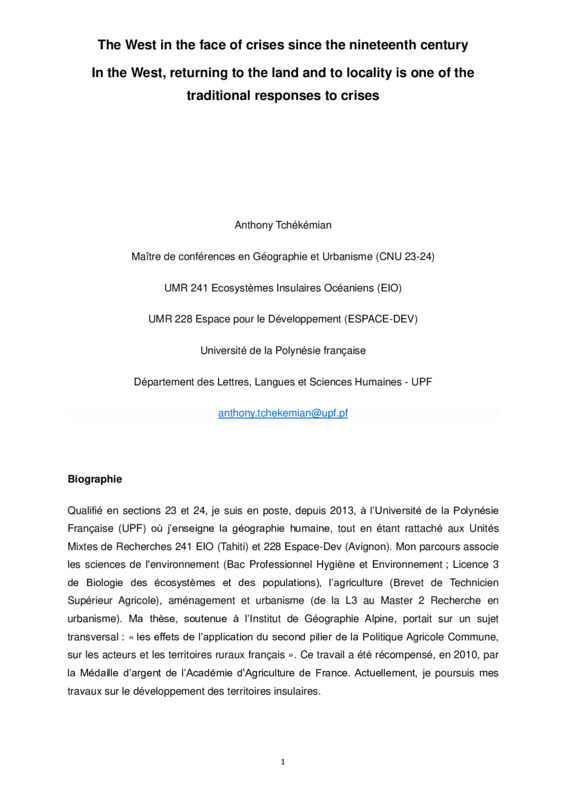 2022
2022The West in the face of crises since the nineteenth century In the West, returning to the land and to locality is one of the traditional responses to crises
Confronted with what may appear to be a series of global crises - health, environmental, economic and even democratic - the ideas on the virtues of what is local and rural are becoming increasingly heard. This article aims at putting this return to locality in historical perspective. For almost three hundred years, Western societies have gone through profound changes, especially economic ones, at the cost of a break with nature, in a more or less dramatic, and more or less painful way. Throughout our recent history, surprisingly diverse voices (political leaders, artists, activists, etc.) have conjured up this return to the land, which has taken on various forms. This return appears to be a providential solution to these disruptive changes. The health crisis due to Covid 19 seems to have not only confirmed, but also exacerbated this trend. -
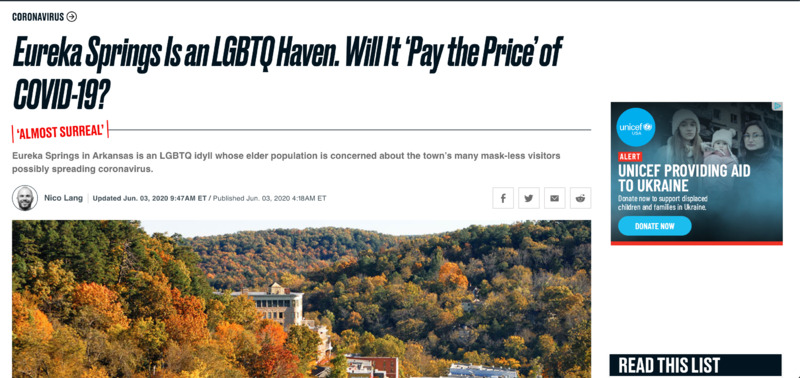 2020-06-03
2020-06-03The Survival of an LGBTQ+ Community in the Bible Belt During the Age of Covid-19
Deep in the Ozark Mountains lies the small resort town of Eureka Springs, Arkansas. This community relies heavily on tourism, shopping, and the many natural spas erupting from within the Ozarks. This community is also home to a thriving LGBTQ+ community in the heart of the Conservative Bible Belt. As Covid quickly enveloped Arkansas and restrictions were placed on activity, Eureka Springs and the LGBTQ+ crowd suffered. While there is a strong Queer population in Eureka Springs, the area is home to a strong evangelical crowd. This article details how the LGBTQ+ community took greeter precautions to protect against Covid, while the Evangelical crowd largely disregarded the pandemic entirely. Covid truly resurfaced a tremendous divide amongst the population of Eureka Springs which had, for the most part, been stable. The nature of pandemic regulations and the adherence or neglect of these regulations spilled over into the greater conflict between Evangelicals and the LGBTQ+ community, an occurrence that would otherwise be non-existent without the presence of Covid-19. This article highlights that while Covid seems to have the primary grip over our lives at the moment, we must be conscious of the impact Covid can have on other areas of life, deep-seeded conflict, and the general safety of vulnerable groups. -
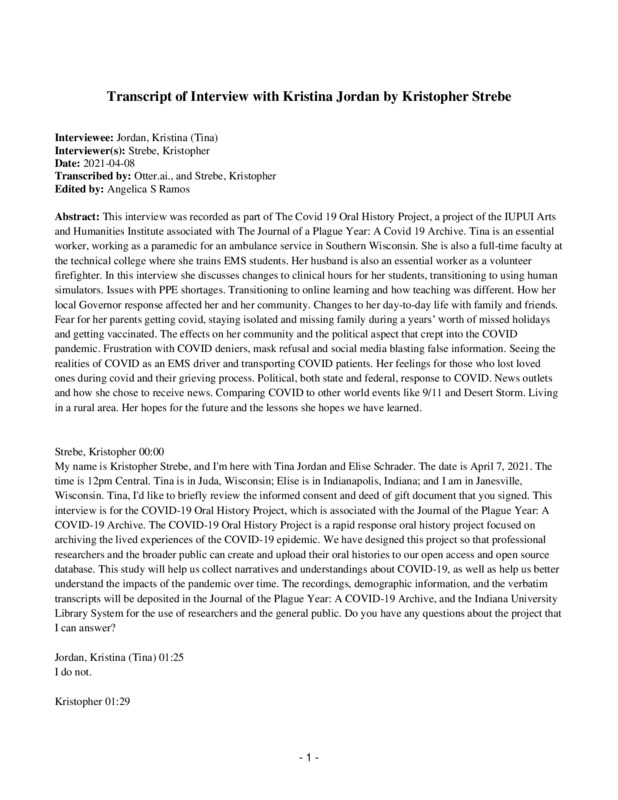 04/29/2021
04/29/2021Kristina Jordan Oral History, 2021/04/08
This interview was recorded as part of The Covid 19 Oral History Project, a project of the IUPUI Arts and Humanities Institute associated with The Journal of a Plague Year: A Covid 19 Archive. Tina is an essential worker, working as a paramedic for an ambulance service in Southern Wisconsin. She is also a full-time faculty at the technical college where she trains EMS students. Her husband is also an essential worker as a volunteer firefighter. In this interview she discusses changes to clinical hours for her students, transitioning to using human simulators. Issues with PPE shortages. Transitioning to online learning and how teaching was different. How her local Governor response affected her and her community. Changes to her day-to-day life with family and friends. Fear for her parents getting covid, staying isolated and missing family during a years’ worth of missed holidays and getting vaccinated. The effects on her community and the political aspect that crept into the COVID pandemic. Frustration with COVID deniers, mask refusal and social media blasting false information. Seeing the realities of COVID as an EMS driver and transporting COVID patients. Her feelings for those who lost loved ones during covid and their grieving process. Political, both state and federal, response to COVID. News outlets and how she chose to receive news. Comparing COVID to other world events like 9/11 and Desert Storm. Living in a rural area. Her hopes for the future and the lessons she hopes we have learned. -
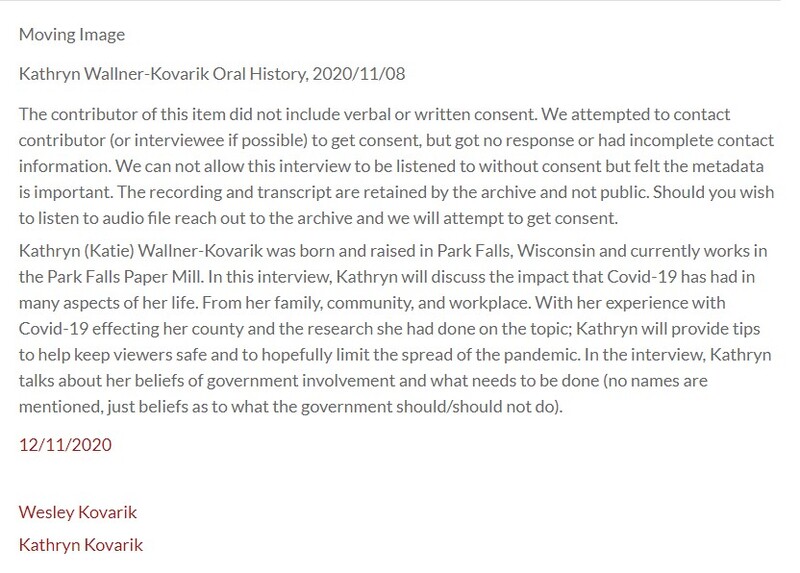 12/11/2020
12/11/2020Kathryn Wallner-Kovarik Oral History, 2020/11/08
The contributor of this item did not include verbal or written consent. We attempted to contact contributor (or interviewee if possible) to get consent, but got no response or had incomplete contact information. We can not allow this interview to be listened to without consent but felt the metadata is important. The recording and transcript are retained by the archive and not public. Should you wish to listen to audio file reach out to the archive and we will attempt to get consent. -
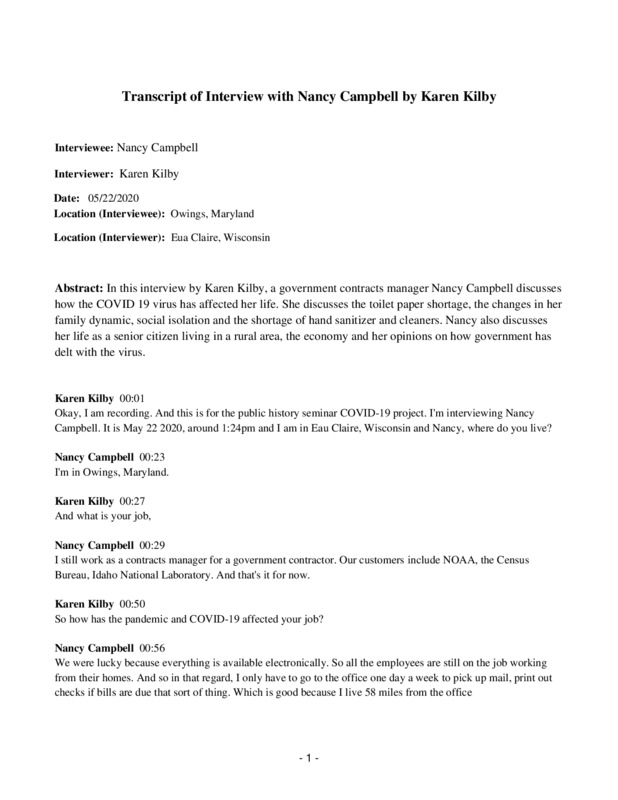 05/22/2020
05/22/2020Nancy Cambell Oral History, 2020/05/22
In this interview by Karen Kilby, a government contracts manager Nancy Campbell discusses how the COVID 19 virus has affected her life. She discusses the toilet paper shortage, the changes in her family dynamic, social isolation and the shortage of hand sanitizer and cleaners. Nancy also discusses her life as a senior citizen living in a rural area, the economy and her opinions on how government has delt with the virus. -
2020-04-02
The Silence of Nature
I live in a rural area of southeastern Louisiana. When I first moved here the only thing that you could hear at night was the natural sounds that one would think of when being in the country, but as developments started to move into my area the air was polluted with the sound of cars on the distant interstate. The nights become a harmony of grasshoppers and traffic all mixed into a melody that formed a hybrid of urban and rural life. On the night of April 2nd, 2020 I was enjoying a night of looking at the stars through my telescope. It was a mainly clear night when I closed my eyes and began listening realized that I could no longer hear the cars on the interstate. Louisiana was in the mist of the a very high spike in COVID and lockdowns were in effect meaning there were fewer cars on the roads especially at night. I sat and listened for hours as I was able to hear all the sounds that were once masked by the intrusion of development on my rural area. From about April 2nd until early July this quite remanded at night. It was not until Louisiana started to open up more that the sound of the cars returned to my nighttime symphony. When I look back on the early days of the pandemic this is the memory that stands out and how it will be remembered by me. Though a harsh time in the world and for humanity, the sounds of technology and modernization were drowned out by nature for a time and it made the nights a little more peaceful and less stressful with all that was going on in the world. -
2021-09-29
Covid in Altus Oklahoma
I wanted to share my personal experience of living through the COVID-19 Pandemic in Altus Oklahoma. While my experience probably looked very similar to others, I believe it is very important to always information share so everyone can have the complete picture. I am active duty Air Force, and was residing in Altus Oklahoma during the pandemic in 2020. Living on a military base, it is not very often that you have quiet hours or down time. However, during the height of the pandemic, the majority of the base shut down and went to minimum manning for almost 30 days. It was strange to see operations halt, and all non essential workers staying home with their families for the duration of the town shut down. Organizations went from in person working to relying on home desktop computers to get the mission done. During this time people were also limited on where they were allowed to travel, and people they were allowed to see. At one point, some people were not even allowed to go on walks outside, because they were not sure how the virus would spread and if it would be safe being close to others. As doctors and scientists started discovering the make up of the virus and how to mitigate against its effects, we started gaining more liberties back. Members were no longer confined to their homes, we were able to do outdoor activities near the base, and were allowed to travel to nearby towns for any essential items. Looking back on the situation that occurred a little over a year ago, it is hard to imagine and remember what it was like to be confined to our homes and not being able to engage in social gatherings. One thing that is pandemic has highlighted to me is that despite all the adversity the world has faced, we are still determined to get the mission done efficiently and effectively everyday. I would also like to highlight the importance of social connectedness and gatherings. During the isolation period of the pandemic, the majority of people suffered from lack of communication and not being able to connect with those around them. If this pandemic has taught us anything it should be to not take your health for granted and to value the time you have with loved ones, because you never know when it will be your last time together. -
2021-09-29
Covid in Altus Oklahoma
When reflecting back on the height of the COVID-19 Pandemic in 2019, it is strange to think the whole country was isolated from other people for an upwards of three months or more. I was residing in Altus Oklahoma during the pandemic and there was a point where no one was allowed to leave their homes to even enjoy the fresh outside air. With this, a lot of local organizations were shut down for months including Churches, local eatery's, stores, and even some grocery stores. While I know my story is similar to many others, I believe that it is important to share all experiences with the community. Sharing will create a complete picture of how the pandemic shaped our society today. -
2020-03
Rural Connecticut: Covid Doubters
I lived in a rural part of Connecticut during the 2020 Covid lockdowns. Despite the widely publicized nature of the pandemic, at least half of the citizens in my town didn't believe the disease was real. There was a real divide over wearing masks and closing down schools/work because many people felt the disease was over-blown, not deadly, or simply wouldn't strike a rural place as hard as a city. While my town didn't suffer as much as places like New York City did, we still had Covid cases and deaths across the county. It was frustrating to live in a rural place during the outbreak, because even though we were "safer," than city-dwellers, nobody took measures to preserve that safety. This mindset continued when vaccines became available, and the latest rage in rural areas is using Ivermectin (horse medicine) instead. -
2020-05
Waiting to be Connected
I moved out of New York City for a month in the spring of 2020 during the period where my gallery furloughed most employees aside from the principal directors and a select number of sales people. I spent that time with my father in upstate New York in a close quarters quarantine. I was always struck by the quiet during the day and how visible and bright the stars were at night. Two things that seemed foreign to me at times as I grew up in cities and had lived in various Brooklyn neighborhoods for the past year. The passing sound of car stereos and people’s voices on fire escapes from a floor above were white noise. All vibrant - completely alive - no stars. His apartment was a studio and at the time he had not yet begun paying for internet service. Some nights we would drive four or so minutes down the road to the apartment complex where my Dad used to live a few years prior. We would camp outside the complex’s gym which housed one or two treadmills and the outside looked like a glorified garage - but it had wifi. As we were no longer residents and owners of a key pass to the facility, my Dad would pull up to the side entrance and put on his hazards. I would jump out and begin to search for a signal and attempt to connect to the complimentary internet. Whenever a stray person would emerge from their units to retrieve Amazon packages from their front stoop, I would make uncomfortable eye contact with them, as I held up my phone. Yes, yes, this is what you think it is. They hastened back up and quickly closed their door behind them. I found that the most expedient way of downloading content was to position myself by the exterior front left corner and stand with my back flush against the wall. Every night my Dad and I listened to podcasts and drank tea. Despite everything, moments like these helped us laugh and I look back at this memory fondly. -
2021-08-09
THE19: Howl of a Mad (American) COVID-dodger, a Dia-Rant
A year from the perspective of an immuno-compromised, mulitple comorbidities survivor stranded in place until vaccine in a poor, rural, underserved and politically conservative Colorado ski and summer resort community over run by affluent COVID torurism. -
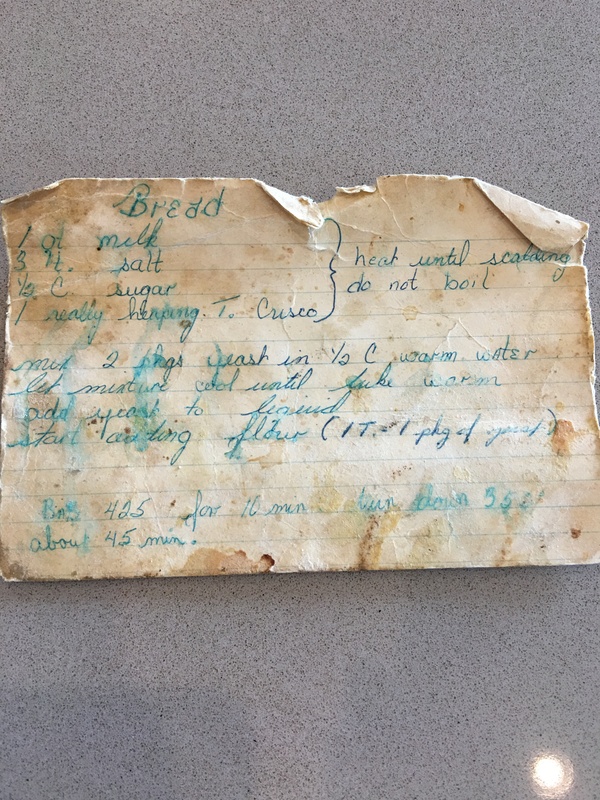 2020-03
2020-03Baking: Impossible
Back in December of 2019, my wife and I were visiting my parents and grandparents in Mesa, Arizona. It was Christmas time, so we were enjoying a bit of leisure time that we typically didn't have. I had just graduated from Brigham Young University-Idaho with a degree in History Education, and my wife just finished a rigorous semester in her study of English at the same school. We were ready for a break. Before meeting up with the family, my grandmother brought up the idea to teach my wife and I how to make homemade bread. It was her grandmothers recipe, and I loved it, as she would occasionally make the dough to make scones or kraut biscuits. This particular recipe made a lot of dough and needed to rise three times. Because of this, making bread was an all day event. Just a few short months after learning to make bread in my grandmother's kitchen, COVID-19 shut down the world. We were living in Rexburg, Idaho at the time-a small town of around 28,000 people located in south-east Idaho. Given that we were in a rural location, we didn't feel the immediate effects of the virus like Seattle, New York City, and Los Angeles. However, around early March, schools shut down and we were told to stay indoors whenever possible. Given that I was a teacher, I was suddenly learning how to run applications like Google Classroom to teach from home. The school district wasn't sure how long I would be working from home for. Initially, they only wanted to close for two weeks to deep clean the school. However, this ended up lasting through the end of the school year. My wife was now also at home. Her studies switched from in-person courses to online courses. Professors who had spent their life in the classroom were suddenly figuring out how to teach via a new medium. It was challenging for all, but everyone seemed to be more patient with each other. Given that my wife and I were home, and given that we had more time, we decided that we would make the bread recipe that my grandmother had taught us over Christmas break. Everyone was encouraged to only shop when absolutely necessary, so we added the flour and yeast to our shopping list. However, when we went shopping only a few days later, the baking isle had been decimated. The only types of flour that were left were expensive bags of specialty flour that came in much smaller portions. Yeast was nowhere to be found. Even things like baking soda were gone. When I think back to the early days of the pandemic, I think of panic. While my wife and I were able to remain calm, many people worried they would not be able to find basic necessities. Grocery stores ran short on many items-toilet paper, canned food, flour, sugar, paper towels, cleaning supplies, amongst other things. Many things that were taken for granted were now an uncertainty. So while we did have more time on our hands, baking bread wasn't an option. -
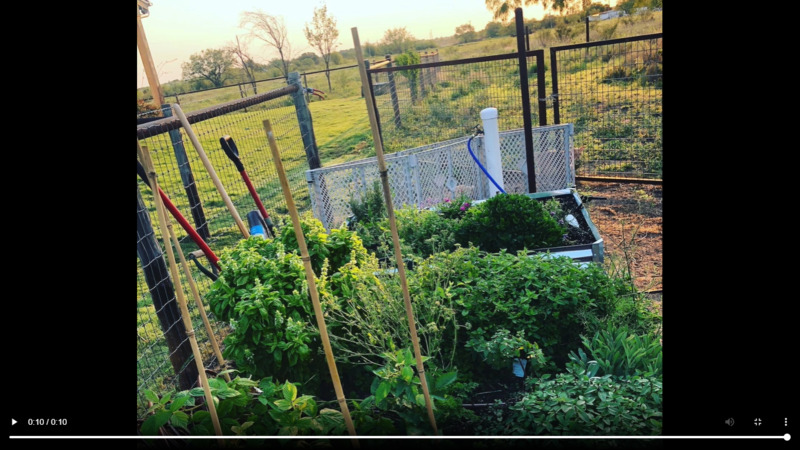 2021-08-06
2021-08-06Covid Gardening Story and Okra Recipe
I chose to focus on my garden and our chickens that we began right before the pandemic hit. I never realized how lucky I was to live in a rural environment until Spring 2020, when living in the country meant having a bit more freedom than in the city. Our garden and chickens provided us with foods that sometimes were out of stock in our small, local store. However, we also faced other things in our community that made the psychological aspects of the pandemic really hard, such as living with those who deny the reality of the disease and mitigation efforts that people like my husband promoted, as an ER physician. I suppose this story is a bit of a love letter to our little property out in the country, despite the differences in values that we have with our town. -
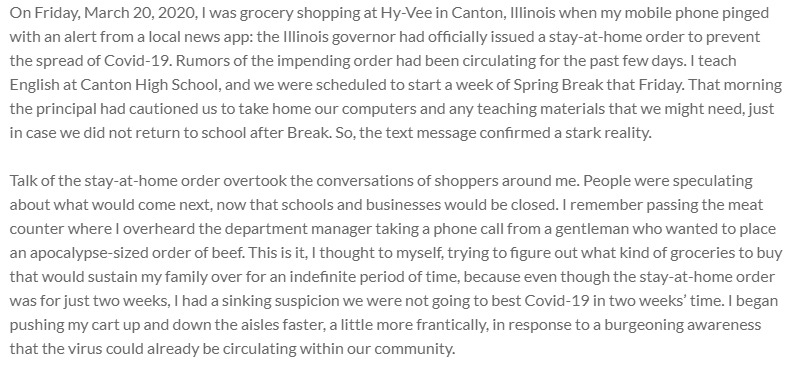 2020-03-20
2020-03-20The Signal of Approaching Silence
On Friday, March 20, 2020, I was grocery shopping at Hy-Vee in Canton, Illinois when my mobile phone pinged with an alert from a local news app: the Illinois governor had officially issued a stay-at-home order to prevent the spread of Covid-19. Rumors of the impending order had been circulating for the past few days. I teach English at Canton High School, and we were scheduled to start a week of Spring Break that Friday. That morning the principal had cautioned us to take home our computers and any teaching materials that we might need, just in case we did not return to school after Break. So, the text message confirmed a stark reality. Talk of the stay-at-home order overtook the conversations of shoppers around me. People were speculating about what would come next, now that schools and businesses would be closed. I remember passing the meat counter where I overheard the department manager taking a phone call from a gentleman who wanted to place an apocalypse-sized order of beef. This is it, I thought to myself, trying to figure out what kind of groceries to buy that would sustain my family over for an indefinite period of time, because even though the stay-at-home order was for just two weeks, I had a sinking suspicion we were not going to best Covid-19 in two weeks’ time. I began pushing my cart up and down the aisles faster, a little more frantically, in response to a burgeoning awareness that the virus could already be circulating within our community. Looking back now, I see that we were somewhat cocooned in Fulton County, Illinois, a mostly rural county. The health department announced the first positive case on April 10; the first death occurred on October 21. The virus was slow to take a foothold, but eventually it did. In late July, our school district’s board unanimously voted to start the school year fully remote. Each school day, teachers reported to ghost-town school buildings and holed up in their empty classrooms, with admonitions from administrators not to co-mingle with each other. During that time, I dutifully logged onto Google Meets for each class period, where various avatars greeted me because students were not required to turn on their cameras, so none did. Sometimes I got to hear tinny student voices, which sounded a lot further away than across town, and I wondered if each voice matched the person I pictured in my mind’s eye. I had never met the majority of my students in person, and the photographs on our school’s student management system had not been updated since the fall of 2019. I remember the frustration I struggled to keep capped when I would call on students and be met with silence. Were they even sitting by the computer? Were they afraid to say something in front of their classmates, lest they look stupid? Were they just willfully ignoring me? Were they okay, physically and mentally? I pulled more words out of students through written assignments and chat boxes than through Google Meets. Although part of the student body returned to in-person school in January of 2021 while the rest remained remote by choice (we taught both groups concurrently), it was still difficult to get students to speak, even to each other. Sadly, many of our students had become so accustomed to the idea of school as a radio broadcast—one from which they could easily disengage if they so wished—that they no longer felt it necessary to contribute their voices. In Illinois, we’ve been told that all students will return to in-person learning in the fall of 2021, with few exceptions, but I fear the virus has done irrevocable damage to our students’ speech. -
 2021-05-28
2021-05-28Alaska face mask sign in rural arctic camp
Cute face mask sign on front of arctic store on the Yukon river in Alaska. -
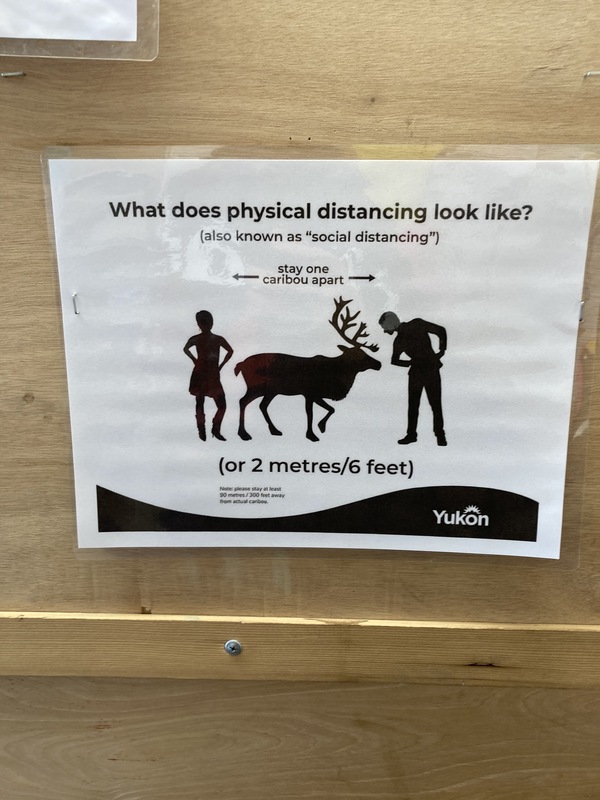 2021-05-28
2021-05-28Yukon Social distancing graphic
Found in entrance of remote camp on the Yukon river in Alaska. -
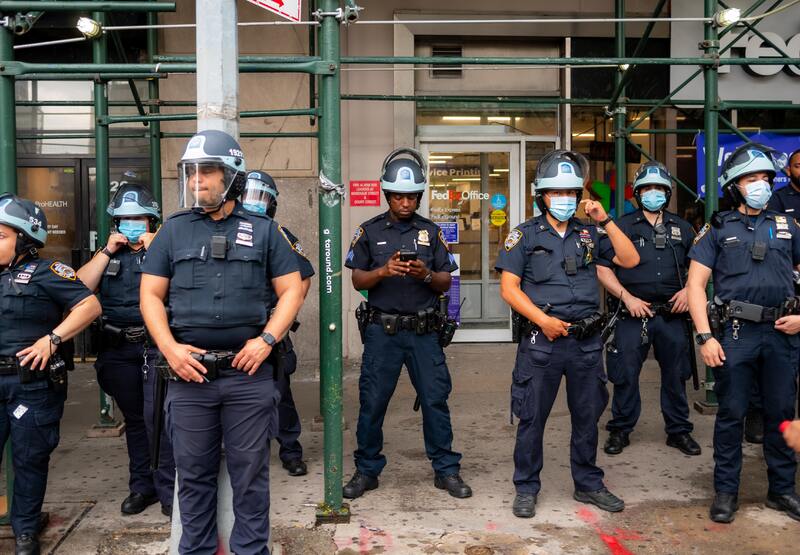 2021-04-26
2021-04-26Image Submission for LE Collection Call
[1] This copyright-free image, courtesy of pexels.com, shows Corporal S. Brantley from the Wheeling (West Virginia) Police Department monitoring a protest. [2] This copyright-free image, courtesy of pexels.com, shows officers from the New York City Police Department, some of whom wear COVID face masks, beneath scaffolding on a sidewalk. -
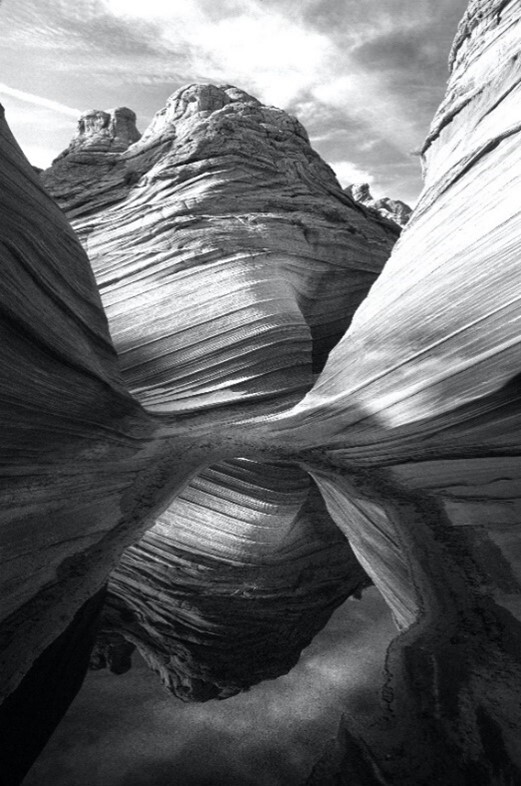 2021-04-20
2021-04-20Images and Audio from "Arizona's COVID-19 Pandemics" Exhibit
During March and April 2021, I created an online exhibit from content within Arizona State University's "A Journal of the Plague Year" COVID-19 archive. Entitled "Arizona's COVID-19 Pandemics," the digital exhibit contained images previously submitted to the archive, along with several copyright-free images I found on pexels.com. I have attached all these images. Listed by their order of appearance within the exhibit, their sources are as follows: 1- "Face It" Campaign flyer: Coconino County Health & Human Services ( https://covid-19archive.org/s/archive/item/42998 ) 2- Red Rocks, Sedona: Courtesy of Gregory Whitcoe via Pexels.com 3- Online Learning: Courtesy of August de Richelieu via Pexels.com 4- Tséhootsooí Medical Center staff: Courtesy of FDIHB Marketing Department and Navajo Times newspaper ( https://covid-19archive.org/s/archive/item/41189 ) 5- Arizona's Mask Mandate Map: created by Sarandon Raboin ( https://covid-19archive.org/s/archive/item/26267 ) 6- Arizona COVID-19 Infection Zip Code Map: Courtesy of Arizona Department of Health Services ( https://covid-19archive.org/s/archive/item/42035 ) 7- Woman Shopping: Courtesy of Anna Shvets via Pexels.com 8- Woman on Rural Arizona Road: Courtesy of Taryn Elliot via Pexels.com 9- Masked Woman in Crowd: Courtesy of Redrecords via Pexels.com 10- The Wave: Courtesy of Flickr via Pexels.com (this image is found only in the PDF submission of the exhibit, not in the public-facing exhibit itself due to document formatting technicalities - the PDF version can be found at https://covid-19archive.org/s/archive/item/42998 ) -
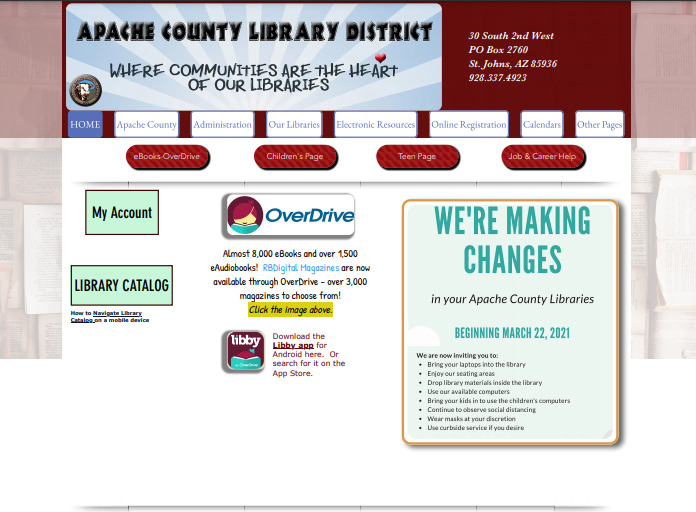 2021-03-22
2021-03-22Apache County (AZ) Library COVID-19 Guidelines after March 22, 2021
This copyright-free image of a public-facing government webpage displays the COVID-19 protocols in place at Apache County (AZ) library locations after Governor Doug Ducey ordered local governments to phase out public health mandates on March 22, 2021. Unlike urban areas within the state, rural Apache County in northeastern Arizona no longer required mask use inside private or government (public) buildings and facilities. -
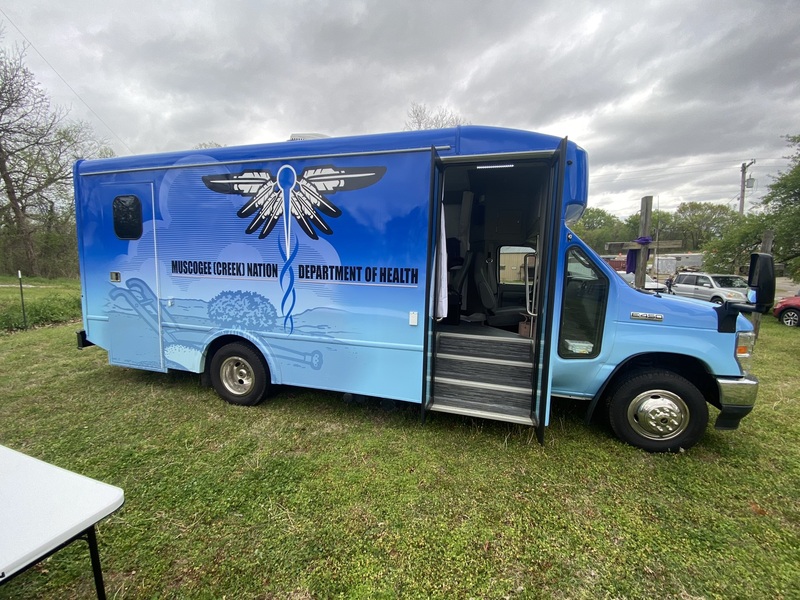 2021-04-10
2021-04-10Muscogee (Creek) Nation provides mobile COVID-19 vaccine units to help rural Oklahomans get shot
The Muscogee Creek Nation began a campaign in Oklahoma to provide COVID-19 vaccines to rural residents. The mobile vehicles feature refrigeration units and enough room for three nurses to work on administering the vaccine, completing the paperwork, and entering the data to the online system. "I'm not aware of anyone else taking vaccine into communities via a mobile unit so we are really excited to be able to expand this service into our rural communities and we hope to increase vaccination rates because of it," said Shoneen Alexander-Ross, Chief Performance Officer with the Muscogee (Creek) Nation Department of Health. -
 2020
2020Cultural Survival: disaggregation of data of, for, and by Indigenous Peoples
"Due to the need to present information disaggregated by Indigenous Peoples, Cultural Survival is producing this map to collect and disseminate information to show the situations Indigenous communities are facing as a result of COVID-19. As the number of cases increase daily, and the lack of access to testing in rural areas, the data presented here will evolve over time. Empty areas do not imply that there are no cases of COVID-19 or human right violations. This is a continuous and not exhaustive effort and we invite Indigenous Peoples and their communities to contribute. [...] Our COVID-19 response features a holistic, multi-layered approach including curating a global monitoring system for COVID-19 for Indigenous communities using Google maps technology to document COVID-19 cases and related human rights violations." -
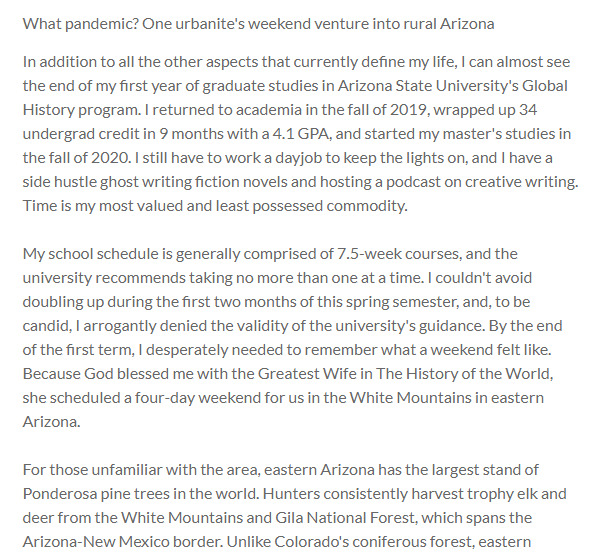 2021-03-04
2021-03-04What pandemic? One urbanite's weekend venture into rural Arizona
In addition to all the other aspects that currently define my life, I can almost see the end of my first year of graduate studies in Arizona State University's Global History program. I returned to academia in the fall of 2019, wrapped up 34 undergrad credit in 9 months with a 4.1 GPA, and started my master's studies in the fall of 2020. I still have to work a dayjob to keep the lights on, and I have a side hustle ghost writing fiction novels and hosting a podcast on creative writing. Time is my most valued and least possessed commodity. My school schedule is generally comprised of 7.5-week courses, and the university recommends taking no more than one at a time. I couldn't avoid doubling up during the first two months of this spring semester, and, to be candid, I arrogantly denied the validity of the university's guidance. By the end of the first term, I desperately needed to remember what a weekend felt like. Because God blessed me with the Greatest Wife in The History of the World, she scheduled a four-day weekend for us in the White Mountains in eastern Arizona. For those unfamiliar with the area, eastern Arizona has the largest stand of Ponderosa pine trees in the world. Hunters consistently harvest trophy elk and deer from the White Mountains and Gila National Forest, which spans the Arizona-New Mexico border. Unlike Colorado's coniferous forest, eastern Arizona seems devoid of pine beetle kill. Nothing but healthy, evergreen forest and the scent of sun-warmed pine greets you. We stayed in a vacation home on the outskirts of Pinetop, brought our groceries from home, and largely intended on hiking, cooking, drinking, and doing a lot of nothing. When we arrived in Pinetop in early March 2021, I had already fully recovered from COVID-19 and had time for both of my Moderna vaccines to have taken full effect. My wife had neither protective barrier, but we had generally become comfortable with purpose-driven shopping (as opposed to "window shopping") and takeout dining. As such, we stopped into a bakery to get breakfast on the way out to the hiking trails as a vacation treat. To our surprise, many of the patrons weren't wearing masks while walking through the restaurant or waiting in line. That made us a little uncomfortable. Then, one of the employees walked out from the kitchen with no mask on and began working on filling orders at the front, cold-food storage counters. Both of us panicked a bit and considered cancelling our orders and leaving. My wife pulled up the Arizona Department of Health Services site and quickly found that entire county had endured only a little more than 560 cases. A quick bit of division translated that into an average of two infections per day for the entire pandemic year-to-date. The statistical odds of the unmasked clerk or patrons presenting a health risk to either of us fell to just north of zero. NOT zero, but we both felt we could see it from there. The ham, egg, and cheese croissants were delicious, by the way. In trying to be good guests, we continued to wear our masks whenever we ventured into public spaces and businesses. Less than half of those around did the same, and I didn't see or hear anyone confront each other about mask wearing. Our last venture out that weekend was to a beer garden with a prominent outdoor patio and seating area. We again wore our masks inside the establishment, but we immediately felt like outcasts for having done so. When we stepped inside, it looked as though the town villain had just stepped through the saloon doors: all activity inside the business stopped, and everyone seated inside turned around to look us up-and-down for few silent moments. If anyone had been playing piano, they would have switched to a minor key. NO ONE else inside wore a mask, and the interior tables didn't appear to have been spaced to comply with prevailing social distancing guidelines. Everyone stayed kind of quiet until we ordered beers and asked to sit outside. In hindsight, I wonder if they expected we were there from some government bureaucracy to issue citations, or just out-of-towners about to have a value-based hissy fit? I have been generally opposed to broad behavior mandates that typically justify compliance on urban problems, but that weekend compelled me to really consider the divergent pandemic realities Arizonans have endured for the past year. Further analysis of county-specific data seems to suggest at least four divergent pandemic experiences within Arizona: urban centers, border counties, rural counties, and Native American reservations. I hope to better understand the personal experiences of those who lived in these diverse regions and how the pandemic affected their perspective and reality. -
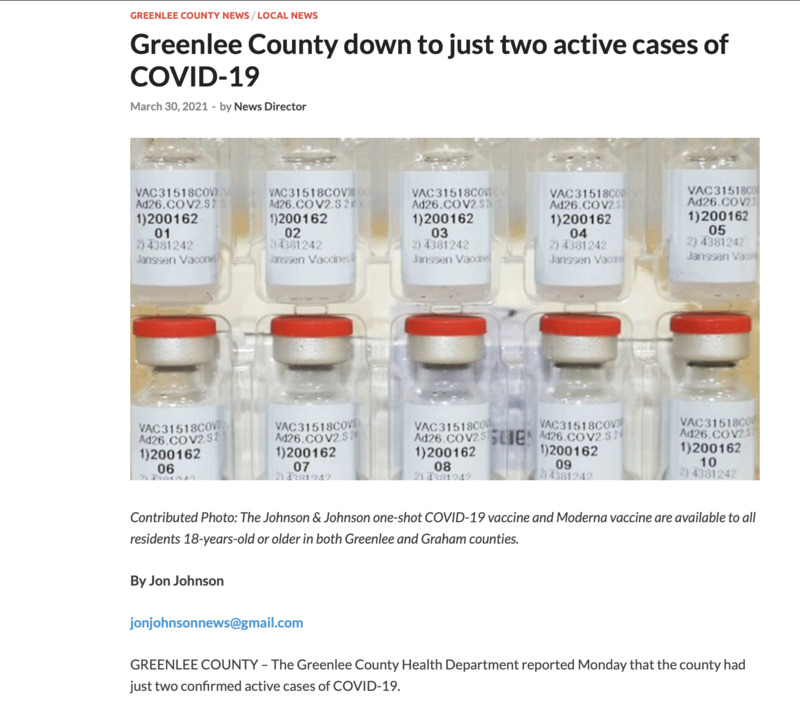 2021-03-30
2021-03-30News Article: Greenlee County (AZ) down to just 2 active COVID-19 cases
"By Jon Johnson, jonjohnsonnews@gmail.com GREENLEE COUNTY – The Greenlee County Health Department reported Monday that the county had just two confirmed active cases of COVID-19. Greenlee County has tested more than 5,000 people for the course of the pandemic and has had a total of 568 cases, with 556 recovered and 10 deaths. The county offers the Moderna COVID-19 vaccine to all residents 18-years-old or older, and on Thursday (01-April-2021) Gila Health Resources will have a vaccine clinic for the one-shot Johnson and Johnson COVID-19 vaccine. Click here to learn more or to register. According to the Arizona Department of Health Services, 37.5 percent of Greenlee County’s residents have been vaccinated for COVID-19. That is the highest percentage out of Arizona’s 15 counties. Conversely, Graham County is listed as having just 18.1 percent of its population vaccinated, which is the third-worst out of Arizona’s counties behind Maricopa County at 17.5 percent and Apache County at 10.7 percent. Graham County: The Graham County Department of Health and Human Services reported three new confirmed positive tests for COVID-19 on Tuesday. While Graham County has had 5,364 total confirmed cases of COVID-19, as of Tuesday the county had just 138 confirmed active cases. Out of all its confirmed cases, 5,150 are listed as being recovered, and 76 have died. Graham County is also offering both the Moderna and Johnson & Johnson vaccines to all residents 18-years-old or older. Click here for more information." -
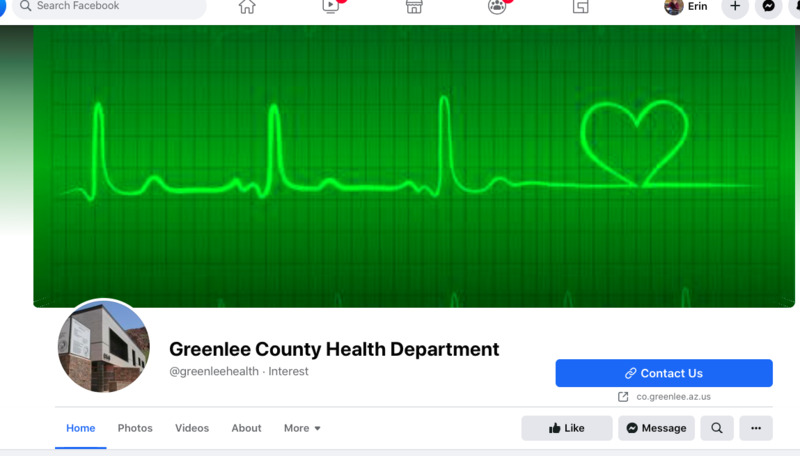 2021-04-05
2021-04-05Greenlee County (AZ) Health Department's Daily COVID-19 Updates through April 5, 2021
The Greenlee County Health Department uses its Facebook page to disseminate daily information related to the COVID-19 pandemic to its residents. The daily COVID-19 statistics are displayed as an image on the daily Facebook post, which allows examination of the department's content and messaging before and after the pandemic. Governor Doug Ducey declared a state of emergency in Arizona on March 11, 2020, which seems inconsistent with GCHD's daily posts from that period. Language on the GCHD posts consistently advised residents to stay home if they felt ill, rather than being consistent with Governor Ducey's voluntary Stay Home orders. For example, the March 30, 2021, press release to update a new active COVID-19 infection in Greenlee County reads as follows: "For Immediate Release, Tuesday, March 30, 2021, Greenlee County, Arizona. Public Information Contact: Steve Rutherford (928) 865-2601 NEW RELEASE - COVID-19 Positive Test in Greenlee County The Greenlee County Health Department is investigating one (1) new confirmed case of COVID-19. The case will put our current total at five hundred and sixty-nine (569) confirmed Greenlee County COVID-19 cases... We would like to remind the community to use masks appropriately when outside of the home, practice social distancing, wash your hands frequently, and do not go into the public when you are feeling sick, unless you are seeking medical attention." These updates demonstrate a significant dichotomy between the rural and urban experiences during this pandemic. -
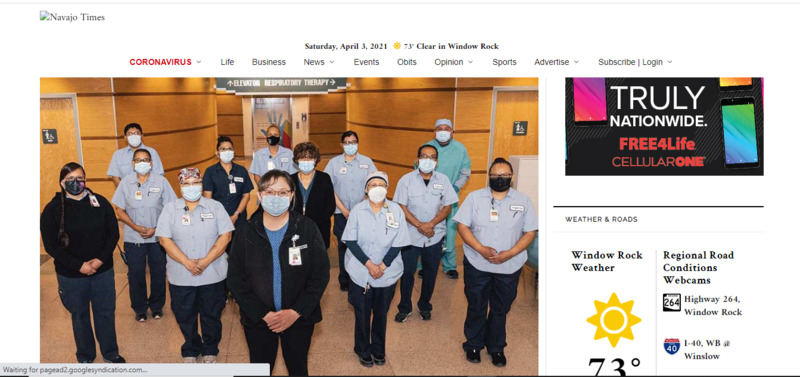 2021-03-26
2021-03-26‘They became warriors’: Reflections from the front lines as Tséhootsooí Medical Center workers share experiences
By Rima Krisst | Mar 26, 2021 | CORONAVIRUS, People | Tséhootsooí Medical Center workers share experiences Wilberta “Billy” Jackson, public health nurse III This pandemic has been the longest roller coaster of stress, grief, and loss. I’ve kept my routine simple – sleep, eat, and exercise. And, more sleep. This has been and will probably be the most challenging time of our lives. I could focus on all the bad, but so much good has come from this, from community members stepping up, leaders rolling their sleeves up and getting dirty, how we came together to care for our elders, and so much more. Professionally, we’ve adjusted and readjusted a million times over and completely changed how we deliver health care. We’ve had information, guidance, and policies being added or changing every day and we still were able to deliver health care in a safe, efficient manner. At the beginning of the pandemic, our leaders were warning everyone about the health care system being overwhelmed. Most people thought about it in terms of hospitals running out of beds, but they didn’t think of it in terms of how an underfunded and shorthanded public health force would respond to a pandemic in a rural area with limited resources, and where a population’s most basic physiological and safety needs are not being met. When you don’t have access to clean water, food, shelter and security, you’re not able to prioritize prevention measures until your basic human needs are addressed. The resiliency of the Diné people is unrivaled. The days I’m struggling or feel like giving up, I hear my grandmother’s words, and that’s what keeps me going. And my mother’s surprise delivery of Navajo soul food meals. I’m a public health nurse, so it won’t come as a surprise that I’m excited about the COVID vaccines. We’ve already seen a substantial decline in cases, hospitalizations, and deaths, so we know it’s working. My hope is that our response to the next pandemic or health care crisis won’t be complicated by politics, lack of national strategy, lack of preparation, and misinformation. Stacey Burnside, Primary Care registered nurse What I have learned from this pandemic is to cherish every day and every person that you love. COVID-19 has impacted my family and me profoundly. I lost an uncle and an aunt to COVID-19, and to this day, it is surreal that they are gone. As a primary care nurse, it is difficult to hear about losing a patient to COVID-19, and at the peak, it was almost a daily occurrence… The challenges that I faced during this pandemic were adapting to the changes in work roles and being separated from the people I love. The clinic that I worked in was closed when the pandemic hit the first peak, and I, along with my coworkers, was informed that we had to work in the Emergency Room. The moment that I saw a patient who needed me to be their nurse, despite having COVID-19, humbled me. That moment in the ER humanized COVID-19 for me and made me realize that I was put there for a reason. No matter what the situation is, nurses adapt, and the teamwork and strength we draw upon each other are phenomenal. A huge hit to me personally and professionally was losing a friend to suicide … dealing with grief, loss, and stress has been a daily thing. What has helped me is drawing strength from my God, husband and son, and family. There are many negatives to the pandemic, but one positive that many have seen is the love and strength we have found among our families. I am thrilled that we are at a point of a high vaccination rate in the Navajo Nation. I remember when I administered my first COVID-19 vaccine to a patient, it brought tears to my eyes, and I cried after work. Leah Chattin, respiratory therapist I’ve been a respiratory therapist since 2003. What I experienced throughout the first surge of COVID-19 here on Dinetah is not what you prepare for. I see the impact on my life as deep internal scars that I buried and to resurface those experiences is a nightmare. Imagine the inability to fully take a deep breath, something so simple we take for granted. Supporting my patients with breathing treatments, providing chest physical therapy, changing breathing devices constantly because the demand for oxygen escalates all in a 12-hour or more shift. All these specialized techniques to avoid the last option of intubation, allowing an artificial airway introduced to your trachea with an opening at the tip to provide mechanical breaths from a mechanical ventilator. Fear expressed from my patients was a frequent emotion. You are alone, isolated from your family, your loved ones, no familiar face to embrace, to celebrate your improvement or the worst, a decline despite the battle you have endured. I’d remind my patients not to give up… Instinct took over because I’m a mother too, a nurturer. I can remember softly stroking their hair, holding their hands, shedding tears, praying, putting myself in that empty place at bedside where your family should be gathered, processing the grief. Accepting loss was tremendously difficult. I lost myself because I did not decompress my emotions. My spirit slivered away slowly each time my patients faced rejection of our efforts to sustain life. How I endured and sustained my sanity was prayer requests. Prayer was undoubtedly my saving grace. This virus is fluidic, the path it took was unpredictable. I strongly believe we need to continue wearing a mask, following the CDC guidelines and begin or sustain our health and wellness. Putting into words my experience was not an easy effort, however it’s a pathway for healing. Every COVID patient I battled for will forever have a place in my heart. Sandra Fouser, nurse executive of the Primary Care and Specialty Clinics Seeing the virus cross the ocean and hit the heart of the Navajo Reservation forever changed our lives. As a health professional, I knew venturing into the unknown with limited protection meant some would survive and some wouldn’t. What I have learned working on the front lines – compassion, cohesiveness, companionship, strength, sadness and mental stress. We have been battered, beaten, praised, comforted and have also received recognition from all walks of life. I am proud to be a nurse. I believe the strength to endure comes from resiliency and the people we work with and the support of our families at home. As nurses, we cannot stand still. I feel it is in our blood to help and move forward. I have lost friends, coworkers, relatives and patients. The grief I feel is palpable, almost more than I can handle. Seeing my family, staff and patients suffer through illness and grief has been very challenging and heartbreaking. As a team, I believe when something happens to one of us, we all feel the effects, we grow closer and find comfort in each other. I see the vaccine as a progression toward eradicating the detrimental effects of this virus and giving us hope that there is a better tomorrow and that Hózhó will be restored. Dr. Karen Williams, hospitalist physician I am a Native physician (Mountain Maidu/Apache) and Indian Health Service Professional Scholar. When the pandemic started our hospitals were suddenly overwhelmed with large numbers of very ill patients needing oxygen. Some patients who worsened were placed on a “life support” or ventilators since they could no longer breathe on their own. Despite our best medical management efforts, including use of high-flow oxygen, there were patients who did not survive. I witnessed more death in a year than I have ever experienced in my career. This was traumatic for me because every day I came to work I felt like I was coming into a war zone. We saw people struggling to breathe and fighting for their life. We heard family members saying their goodbyes to their loved ones and crying over the phone. We held hands of those who took their last breath and witnessed co-workers not able to control their tears. If it were not for our team efforts, almost a military-style mentality, we could not have managed. As a hospitalist physician, the biggest challenge was ensuring that I had the most up-to-date medical knowledge to save a patient’s life. During the beginning of the pandemic many doctors throughout the country did not feel prepared. This was quickly overcome by learning medical strategies used by doctors throughout the world. The treatments used included steroids, anticoagulant medications, and high-flow oxygen. We had the support of our hospital’s incident command leadership and adapted to the changes. This included being able to offer our patients who needed oxygen a federal Drug Administration-approved “emergency use” medication called Remdesivir, and more recently Bamlavinimab for non-hospitalized patients My experiences on the front lines were psychologically and physically overwhelming … I sought support from elders and used my Native spirituality for strength. I also sought protection support from traditional Indian practitioners who set up a tipi and hogan outside the hospital for employees. I sometimes thought twice about the danger I was in. However, I acknowledged that I would never walk away. This is a result of my obligation to the Native community and the hundreds of patients I had gotten to know for so long. I “warriored up” in my mind and sought to do the best I could. I do not foresee an end to mask wearing, and now recognize how careful we all must be to protect each other. I saw too many elders get severely ill and even pass away from COVID as a result of young family members not being careful and bringing it home. I have encouraged community members and my own family to get the vaccine as soon as possible. I received two doses of the Pfizer vaccine and said a prayer in my Native way each time for protection. Natasha Topaha, certified medical assistant, Mobile Unit Overall, this year has been extremely challenging, but also has reinforced my personal strength and resiliency. I have had ongoing concerns throughout the epidemic regarding my kids’ isolation and their mental health. It has been difficult, but doable, to manage both working in health care and supporting my family both emotionally and physically. I had constant worry about bringing the virus home and infecting my family given that I was working in high risk areas and providing COVID testing, vaccines and social and mental health support to patients. I found that doing outdoor activities with my family, such as bike riding and hiking, helped me ease my stress and helped teach my children some healthy coping skills. And we could spend time together! I feel very happy and grateful in both receiving the vaccine and being able to provide it to patients and the community. I feel safer at work and at home now. Johnny Willeto Jr., facility manager/logistics chief The strength to endure comes from within yourself. For me this began in my childhood as the son of Delphine Damon Willeto and Johnny Willeto Sr., who nurtured me to become a great human being. They taught me to be a courageous, productive worker and know my limitations. As a facilities manager, my main focus and responsibilities are the protection in the physical environment of all who walk through the doors of Fort Defiance Indian Health Board’s facilities. All we knew is that COVID-19 was airborne and surface communicated. I treated it as you would tuberculosis and ensured that my staff had adequate PPE to help protect them when they are tasked with working in the patient care areas. This responsibility was a big challenge when trying to procure medical equipment such as masks, gloves, safety glasses, gowns, scrubs, and so forth. Having an MBA has allowed me to flourish in this high stress environment and to adjust with adaptations to finding supplies and creating new relationships with trustworthy suppliers. Being in close proximity to patients who are struggling with getting well can be heart wrenching. Being able to fulfill my duties in the support role to the best of my ability for my community and teammates has allowed me to sleep well at night knowing that I gave it my all. I have lost a brother-in-law who contracted the virus in the Scottsdale area of Arizona. These were very difficult times because as Navajos we are accustomed to comforting each other by a hug or handshake. With COVID, gatherings are not safe, so having family meetings for planning the funeral is off and also the funeral usually consists of 10 minutes before the burial with only a few close family in attendance. One of the biggest assets I have gained is the spiritual belief in God and keeping the communication open by saying my prayers often – to be thankful for the blessings that have come my way or when asking for strength to endure the hardships. In my free time I isolate on the Willeto Sheep Ranch in Goatsprings Valley, Arizona, where I tend 120 sheep and goats. Being able to separate the everyday stress and recharge is paramount to going forward with courage and mental sharpness to make the right choices for the organization, patients and employees. The vaccines are an effective tool to help reduce the mortality of the virus on us and give us protection to this invisible enemy. Corinne Legah, Environmental Service supervisor Personally, I was scared when I first heard of the spread of the virus overseas. It was shocking how fast the virus traveled. In the beginning our team was needed to help keep the hospital sanitized and safe for patients. We reinforced training on the cleaning process for the airborne/droplet virus. I constantly stressed wearing PPE and hand washing. I am so proud of the team for stepping up by protecting our patients. They became warriors to fight the virus. I believe without my husband’s support and God I would not have been able to cope. I have lost friends and family from this virus. It saddens me that many of our people are now in the spirit world. Being a Native and growing up with Navajo beliefs, I had to be strong. My ancestors went through so much and our people are resilient. Prayer is our strength. I cried when I watched the news when the vaccine was given to the first person in the U.S. If everyone gets their vaccine we will be able to interact with family again. I am looking forward to that day! -
 2020-08-21
2020-08-21How Indonesia's Education System Is Faring
"Since March 2020, students, parents, and teachers in Indonesia have been grappling with school closures affecting 62.5 million students from pre-primary to higher education." With such a socioeconomically diverse population, it's difficult to gauge just how accessible isolated learning would really be during the pandemic. The Ministry of Education and Culture had to move quickly to assure that there was some structure and guidelines set in place for educational institutions to follow. Unfortunately, as internet access isn't quite the common luxury many households have, the ministry sought partnership with television programming stations. This was to, at least, provide educational material to those who have access to televisions but not internet. The article goes on to provide four ways in which they hoped would assist in the growing education deficiency. 1) Develop more solutions to reach students without internet access; 2) Increase connectivity and train teachers to deliver more effective and interactive online learning; 3) Identify and support those falling behind with differentiated instruction; 4) Support disadvantaged students to return to school. -
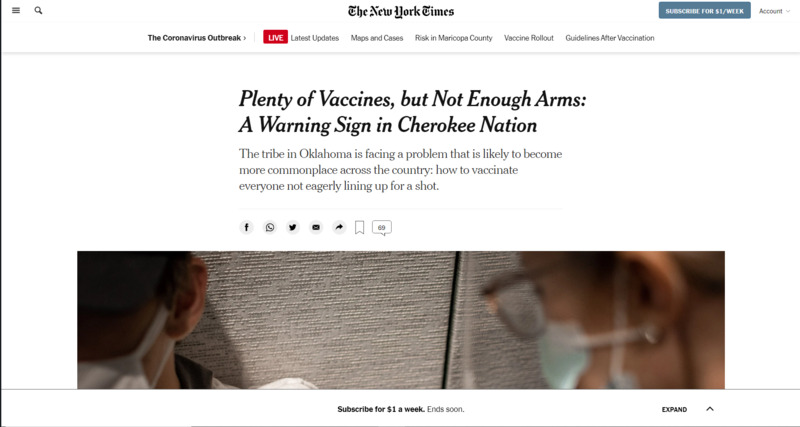 2021-03-16
2021-03-16Plenty of Vaccines, but Not Enough Arms: A Warning Sign in Cherokee Nation
As COVID-19 vaccine efforts are still going strong across the United States, the Cherokee Nation is struggling to get more members of the community vaccinated. Some of the hesitancy to get the vaccine stems from the memory of the government's medical malpractice the greatly affected indigenous people. Other members of the community have questions about the vaccine's side-effects and how it will affect their pre-existing conditions. -
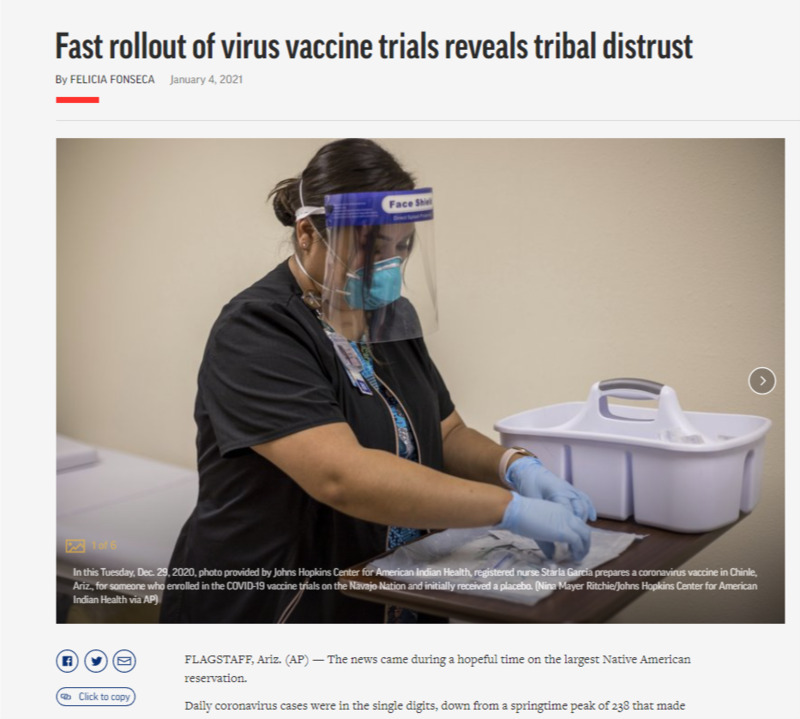 2021-01-04
2021-01-04Fast Rollout of Virus Vaccine Trials Reveals Tribal Distrust
This article discusses why the Navajo Nation is hesitant to participate in the COVID-19 vaccine trials. Although Navajo leaders approved members to participate in the trial, tribal members have expressed extreme hesitation due to lack of informed consent in past experimental trials or the unethical use of tribal medical samples for other experiments. It is important to include this piece in the JOTPY archive as it documents a COVID-19 example of the distrust tribes have held towards the government since the colonization of their lands over the past several centuries. -
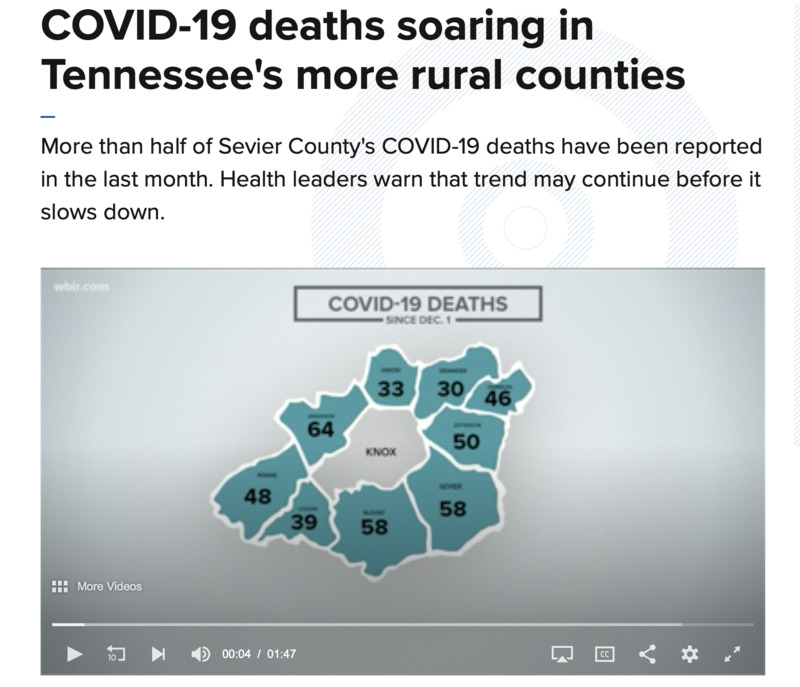 2021-01
2021-01COVID-19 deaths soaring in Tennessee's more rural counties
Over the past several weeks, Knox County and the rural counties surrounding Knox have been hit particularly hard by the pandemic. Tennessee and its rural areas were not hit hard initially by the pandemic, but have become a major area for concern as of late. -
 2021-01-24
2021-01-24SE NM’s Hospital COVID-Bed Capacity
This information displayed on this webpage contains an interactive map with corresponding data summary of the dedicated COVID beds and general capacity of hospitals in southeastern New Mexico for January 24th, 2021. This snapshot demonstrates a reasonably live and present condition of the availability for urgent and emergent COVID medical care within that geographic region and at that date and time. -
 2020-01-11
2020-01-11Silent Bells & Quiet Halls: An Auditory Experience of the COVID-19 Pandemic
In almost every aspect of life, COVID-19 has put the world on mute. From canceled weddings and downsized gatherings to remote workspaces and quiet homes left behind by those we have lost, the overwhelming soundtrack of the pandemic is silence. When K-12 students in the United States transitioned to distance learning nearly 10 months ago, elementary, middle, and high school campuses were abandoned, leaving bells silenced and hallways quiet. From March to November, this silence came to define my work at Princeton Joint Unified School District in the rural town of Princeton, California. No longer did bells ring to mark the end of one period and the beginning of another, lockers no longer slammed shut as students rushed to gather their belongings, and students could no longer be heard gossiping, laughing, and playing during morning break. While this silence initially felt like summer vacation had merely arrived a few months early, the lack of auditory stimulation began to diminish morale and decrease productivity as work felt further removed from the students themselves, transforming human beings into pieces of data and names on a paper. I could often go an entire eight-hour shift without speaking to another person, frequently finding my voice raspy when I would pick up the phone for the first time in hours. Even among coworkers, passing conversations vanished and became simple one-line emails dealing only with the business at hand. As Zoom calls replaced in-person staff meetings and participants remained on mute, the noisy world in which I once worked fell even further away. When in-person learning became optional in November, the sound slowly began to return, but it had changed from what it once was. Growing accustomed to the silence over the long summer, I often found myself jolted in surprise at each unexpected bell or sound of students on the playground. The number of students has drastically lowered since we first closed in March, as many opt to remain home to avoid possible exposure, while lunchtimes are now staggered, and breaks are shortened to prevent spread, creating ominously quiet and often uncomfortable atmospheres. The unease and discomfort heard in students' softened voices displays that widespread uncertainty that has permeated every corner of society. It is my greatest hope that schools will return to "normal" for the 2021-2022 school year and that the sounds of carefree students once more fill the hallways and classrooms of Princeton Joint Unified School District. Silence has become an all-too-painful reality of the COVID-19 pandemic, and I look forward to the day that bells ring on their regular schedule, coworkers are free to converse with one another, and every student returns to campus. In images and articles documenting the pandemic, the overwhelming auditory silence that many of us are experiencing is often lost and forgotten. -
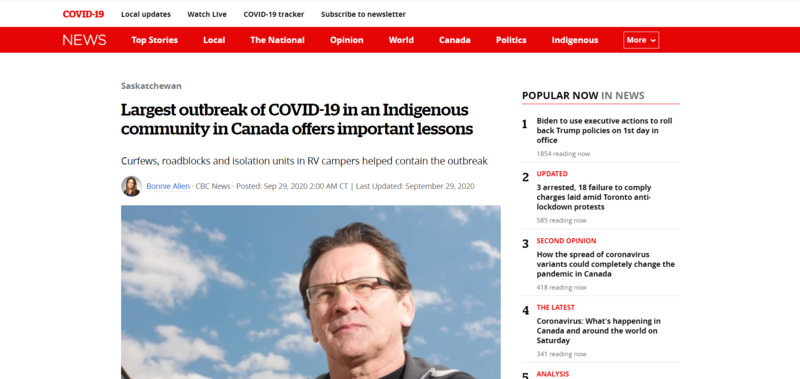 2020-09-29
2020-09-29Largest outbreak of COVID-19 in an Indigenous community in Canada offers important lessons
In the wake of a large outbreak of COVID-19 in northwestern Saskatchewan — the most serious of any Indigenous community in Canada — health officials and local leaders are relying on what they learned during the three-month ordeal to plan for potential outbreaks in other remote, rural areas. -
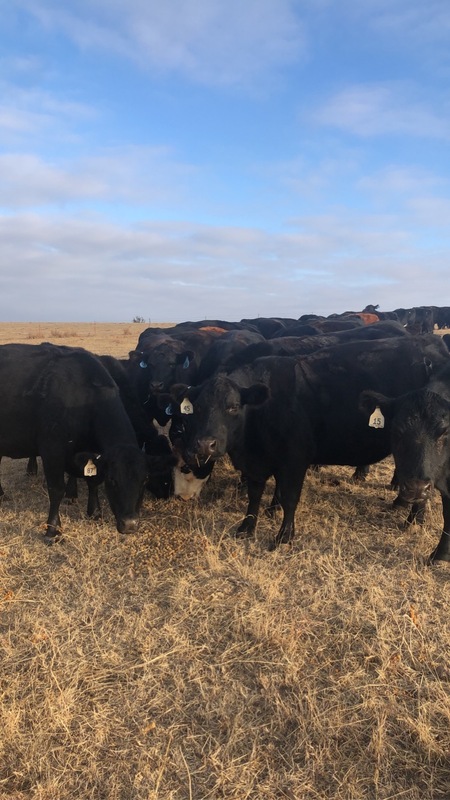 2020-12-05
2020-12-05You can't get Covid from a cow
Being around the countryside has been a relief from the paranoia of the world. The cattle have no clue that the world around them is any different. -
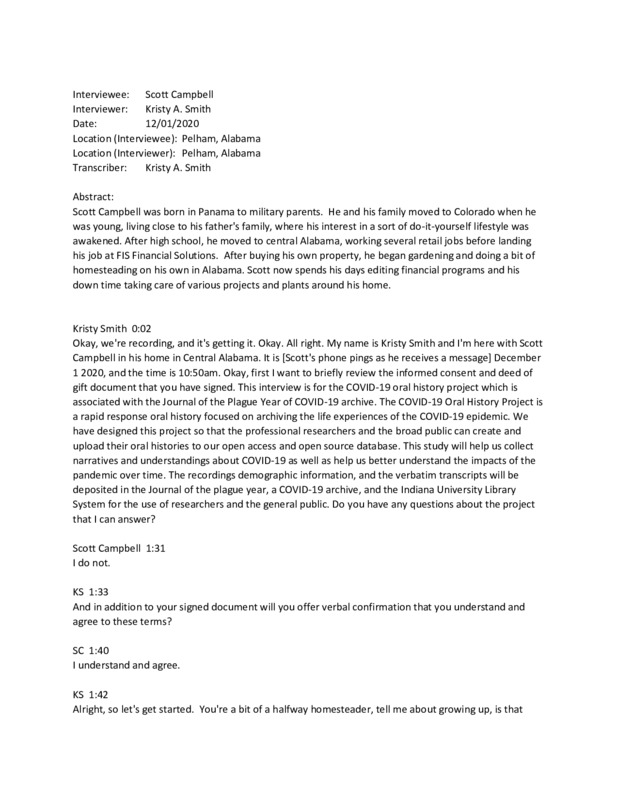 12/01/2020
12/01/2020Scott Campbell Oral History, 2020/12/01
Scott Campbell was born in Panama to military parents. He and his family moved to Colorado when he was young, living close to his father's family, where his interest in a sort of do-it-yourself lifestyle was awakened. After high school, he moved to central Alabama, working several retail jobs before landing his job at FIS Financial Solutions. After buying his own property, he began gardening and doing a bit of homesteading on his own in Alabama. Scott now spends his days editing financial programs and his down time taking care of various projects and plants around his home. -
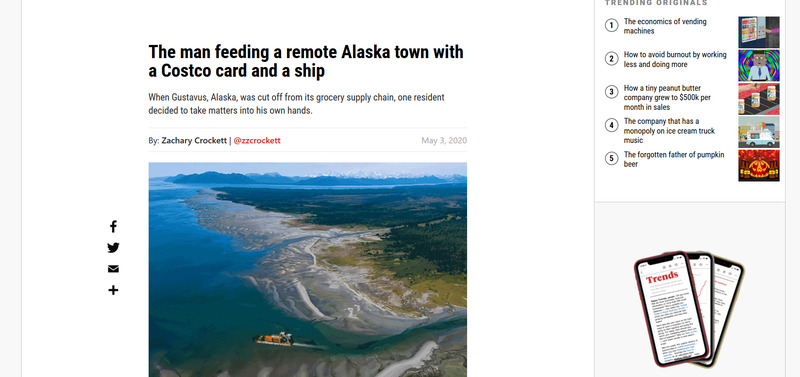 2020-05-03
2020-05-03" The man feeding a remote Alaska town with a Costco card and a ship " - The Hustle
The advent of COVID-19 has made it more difficult for isolated, rural communities to maintain access to basic necessities such as food, water, and personal care products. In an article for the Hustle, journalist Zachary Crokett recounts the story of a Gustavus, Alaska grocer named Toshua Parker, who has taken it upon himself to supply the needs of his fellow townspeople in a time of crisis. Through the use of a shipping freighter, business connections, and a trusty Costco membership card, Parker has mostly succeeded in supplying the community's consumer needs and has made his business, Toshco, an economic pillar of Gustavus. The success of Parker's small, rural business in the face of COVID-19, according to Crockett, is representative of a "renaissance" of rural businesses, which are an important component of supplying a town's consumer needs. Without these businesses, isolated rural communities such as Gustavus would have a harder time enduring the pandemic relative to communities with robust economic centers. -
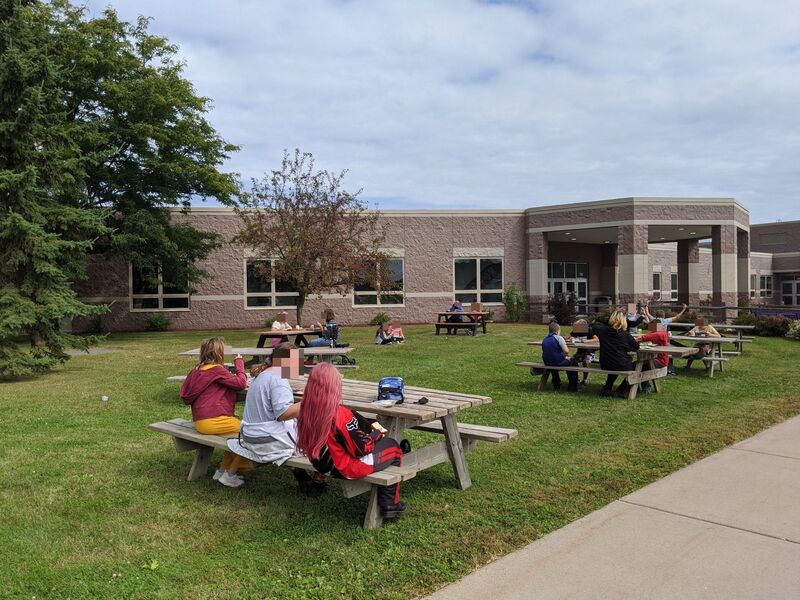 2020-09-11
2020-09-11Wisconsin School Lunch
As a way to mitigate risks for students during lunchtime, the local agricultural society donated picnic tables to the students so they would be able to eat outside with friends mask free. This is important to the pandemic because it shows rural Wisconsin school life and how the community was able to come together to provide for the young students. -
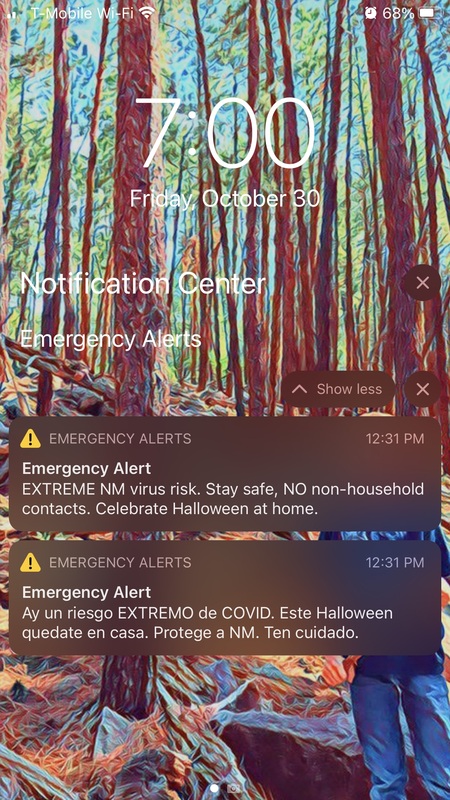 2020-10-30
2020-10-30Concerns From the 4-Corners
This is a screenshot from my phone from this afternoon. I live in Colorado, but depend on New Mexico for several things. I made a quick trip to Target today, and while in the checkout line, everyone’s phones went off. -
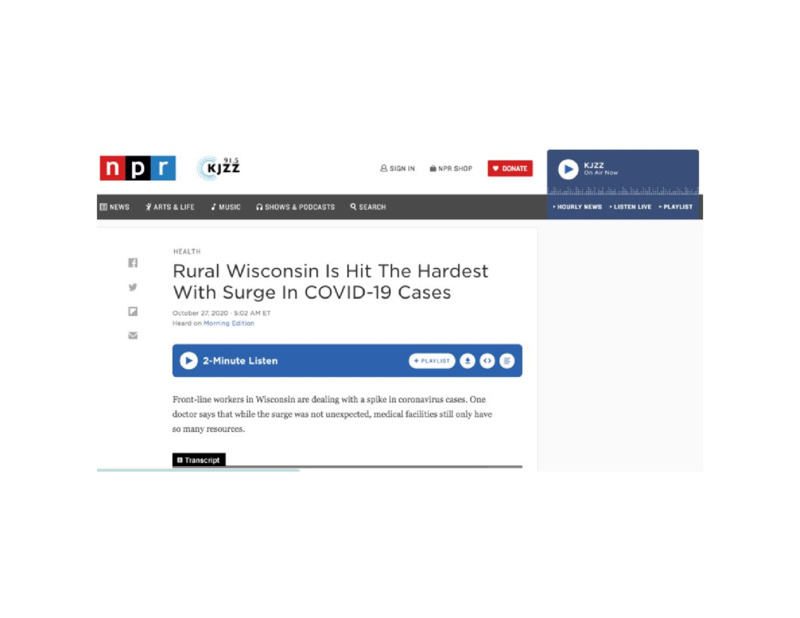 2020-10-27
2020-10-27COVID in Rural Wisconsin
This submission goes into detail from a front line worker on why rural Wisconsin is hit so hard when it comes to COVID, it is important because there are so few voices coming out of this part of the United States. -
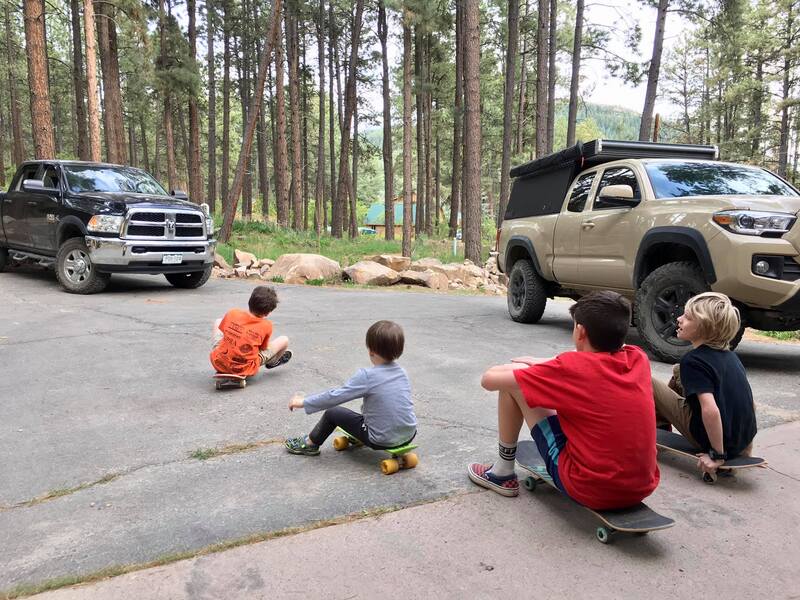 2020-05-20
2020-05-20Birthday Bubble
My son’s birthday was in May. We usually have a big party for him and invite all his friends. This year, by the time May came around, schools were closed so we did not distribute invitations to his classmates like we usually did. Geographically, we live in a bubble. We live in a rural community in a sparsely populated part of the country. So this year, the party was pared down, and took place outside. We invited only a couple friends who all lived within our little neighborhood and we had maintained close contact with since this all began. All went well, and for that I am thankful. -
2020-10-12
Corporate Mask Mandates Not Being Enforced in Oklahoma
I live in Oklahoma and there is currently no statewide mask mandate, nor has there been one since the business shutdowns started in March. When businesses such as Walmart and Walgreens began mask requirements, I assumed this would be at least a barrier of protection for those of us that wear masks. In Oklahoma City and Norman, both nearby larger urban cities, there are city mask mandates. These seem to be somewhat enforced in the stores and very few people are seen not wearing a mask in those cities. In nearby, more rural areas, such as Newcastle. Walmart began store or corporate mask mandates that forced customers to wear a mask. The door's entry was blocked by a guided entry path that led shoppers past a store employee that handed out masks for those that did not have one. This seemed to be a fairly good deterrent for those that avoided masks. By July I was noticing that customers took masks, but then later threw them in the trash. Employees were not enforcing the masks and some customers were avoiding those that didn't wear masks. In September we entered the Newcastle, Oklahoma Walmart and noticed that the entry had changed and Walmart was no longer acknowledging people that did or did not wear masks. By the beginning of October, as COVID-19 cases were reaching high daily numbers in Oklahoma, Walmart customers in Newcastle were now increasingly shopping without masks. My girlfriend and I used to count the number of people that didn't wear masks, it was a mental note of whether things were improving or dissolving. Now, we count those that wear masks. The number that wear masks are consistently lower, than those without. We have been to Walmart more than once since first of October where we were two of less than ten shoppers that had masks. The numbers seem to be on the decline and Walmart is not enforcing its own requirements. The last time we needed products from Walmart, we decided to go to Walgreens in Newcastle instead since it was less crowded. There were only five to six other customers besides us in Walgreens, but we were the only two wearing masks. -
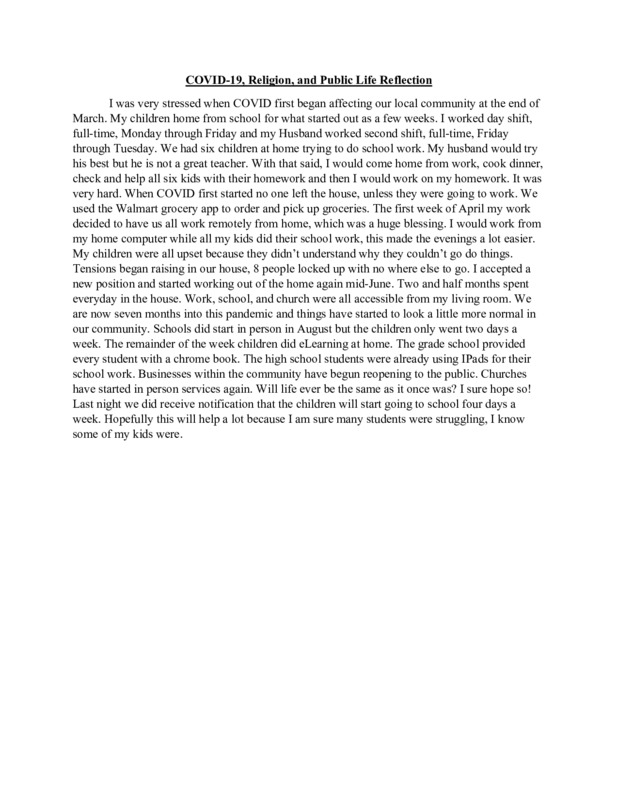 2020-10-03
2020-10-03Smalltown COVID-19
My experience during COVID -
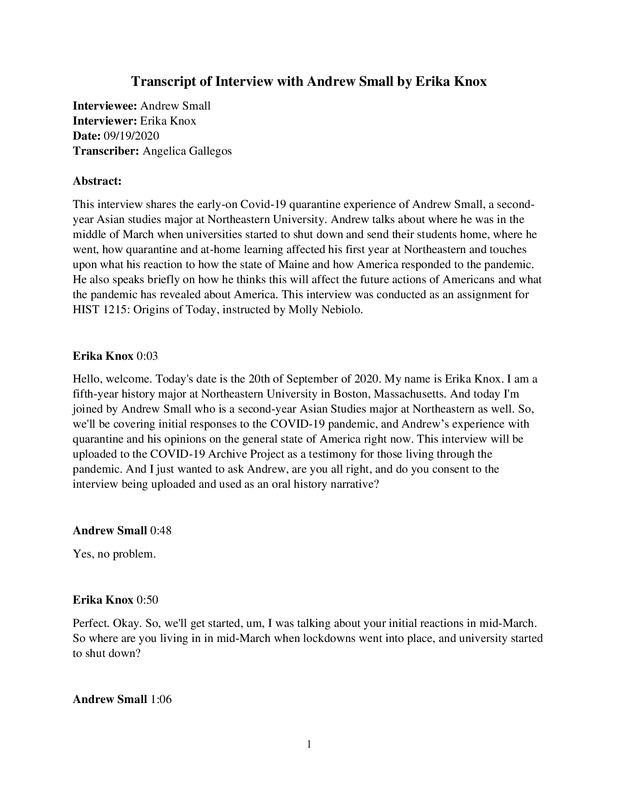 09/20/2020
09/20/2020Andrew Small Oral History, 2020/09/20
This interview shares the early-on Covid-19 quarantine experience of Andrew Small, a second-year Asian studies major at Northeastern University. Andrew talks about where he was in the middle of March when universities started to shut down and send their students home, where he went, how quarantine and at-home learning affected his first year at Northeastern and touches upon what his reaction to how the state of Maine and how America responded to the pandemic. He also speaks briefly on how he thinks this will affect the future actions of Americans and what the pandemic has revealed about America. This interview was conducted as an assignment for HIST 1215: Origins of Today, instructed by Molly Nebiolo. -
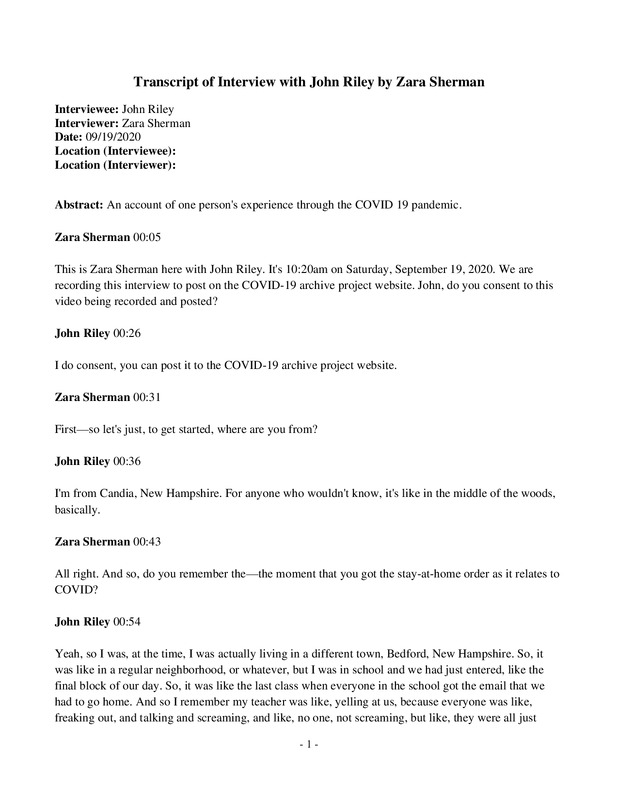 09/19/2020
09/19/2020John Riley Oral History, 2020/09/19
An account of one person's experience through the COVID 19 pandemic. -
2020
Economic Impact of COVID-19 on The United States
This image shows the different economic impacts of each state in comparison with one another. It is interesting that Alaska has been moderately affected and that Florida, New York and Washington state have the highest risk for exposure. This image shows that many middle states have had low exposure when it comes to the economy. -
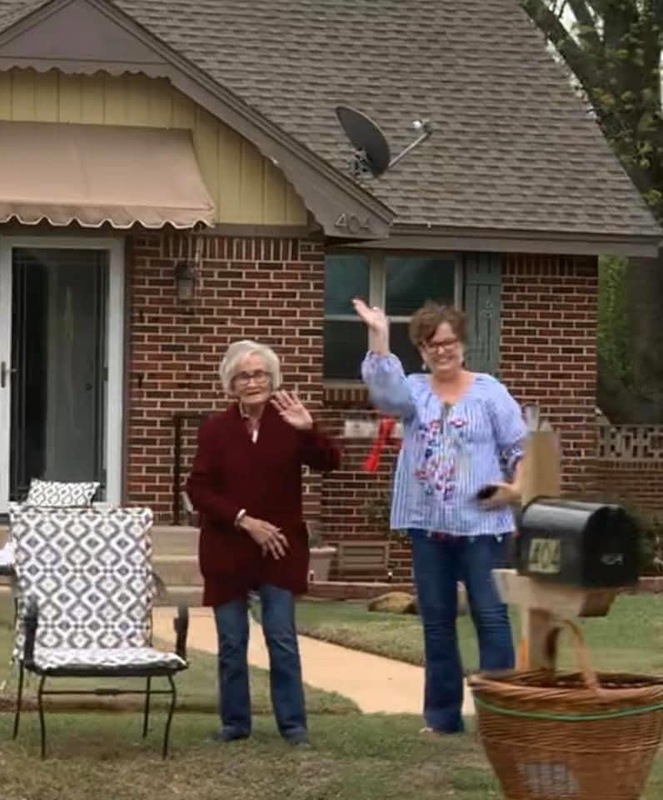 2020-04-11
2020-04-11During Pandemic, Community Adapts "Reverse" Parade to Honor 90th Birthday in Memorable Way
Local resident Genelle Richey retired in 2012, dedicating 62 years of her life to teaching the youth of Blanchard, Oklahoma. Since then, Mrs. Richey's status of being a local educator and mentor as only grown in appreciation. On April 11, 2020 during the peak of COVID-19 shutdowns, the community of Blanchard expressed its gratitude to Mrs. Richey by organizing hundreds of participants to drive past her in a "reverse" parade celebrating her 90th birthday. She and her family gathered on North Main Street to greet the cheerful crowd as they passed. The event was organized by her family and mostly through Facebook to preserve the surprise to Mrs. Richey herself. The event took place between 3:00 and 4:00 PM on that Saturday, April 11. The parade featured vehicles displaying signs and decorated "float" style trailers. The line of vehicles were led by Blanchard Police and Fire Departments. Parade vehicles dropped off birthday gifts and took photographs to preserve the special event. During an otherwise quiet and uneventful month of pandemic closures, the community of Blanchard resiliently came together to adapt a memorable day for a very special woman. Submitted for the #ruralvoices collection. Contributed by Clinton P. Roberts, curatorial intern for Arizona State University, HST 580. -
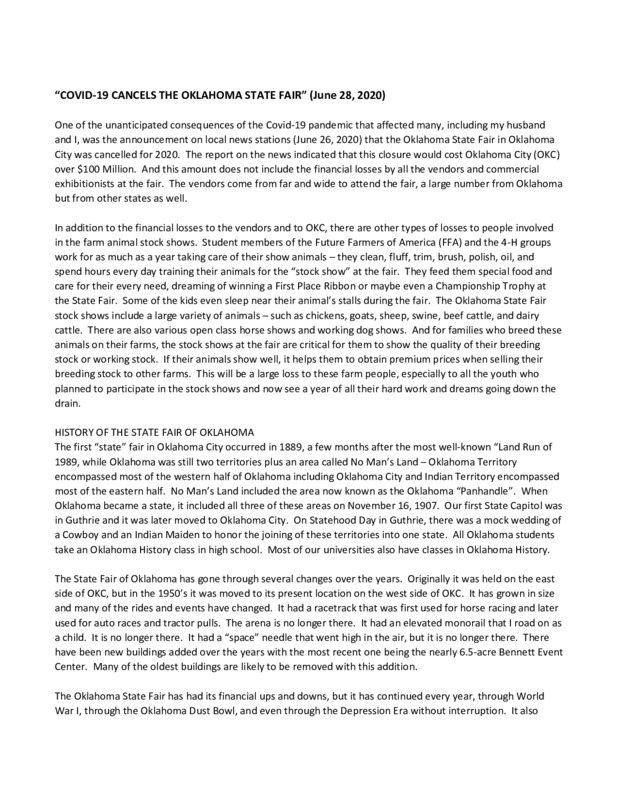 2020-06-28
2020-06-28COVID-19 Cancels the Oklahoma State Fair, Rural Attendee Tells Her Personal Story of Breaking Tradition.
Sharon Annesley of Blanchard, Oklahoma tells the story of how the COVID-19 pandemic has disrupted the traditions of the Oklahoma State Fair. Her text document story chronicles how the State Fair changed over the years, but had never been canceled. She details how this will affect the local economy of vendors, agriculture, and local tourism. She also describes what a typical day for her and her husband would be at the fair and the long-standing tradition it has become to them. Text document authored by Sharon Annesley. The story is titled under the heading “COVID-19 CANCELS THE OKLAHOMA STATE FAIR” (June 28, 2020) The story features personally gathered information and accounts by Sharon Annesley. This document was hand-submitted in a physical form for submission to Clinton P. Roberts for the #ruralvoices collection. Contributed by Clinton P. Roberts, curatorial intern for Arizona State University, HST 580. -
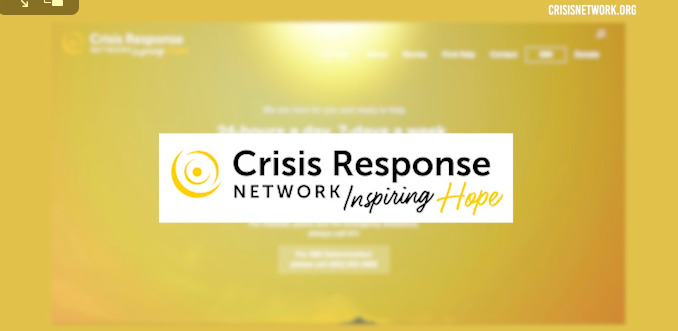 2020-08-14
2020-08-14Rural Arizonans gain more access to mental health resources, but only if they have an internet connection
Sarandon Raboin/Luce Foundation: Southwest Stories Fellowship -
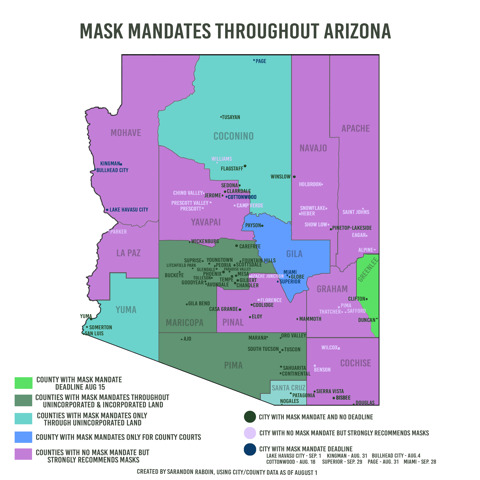 2020-08-11
2020-08-11Mayors in rural Arizona debate the pros and cons of mandating masks in their communities
Sarandon Raboin/Luce Foundation: Southwest Stories Fellowship -
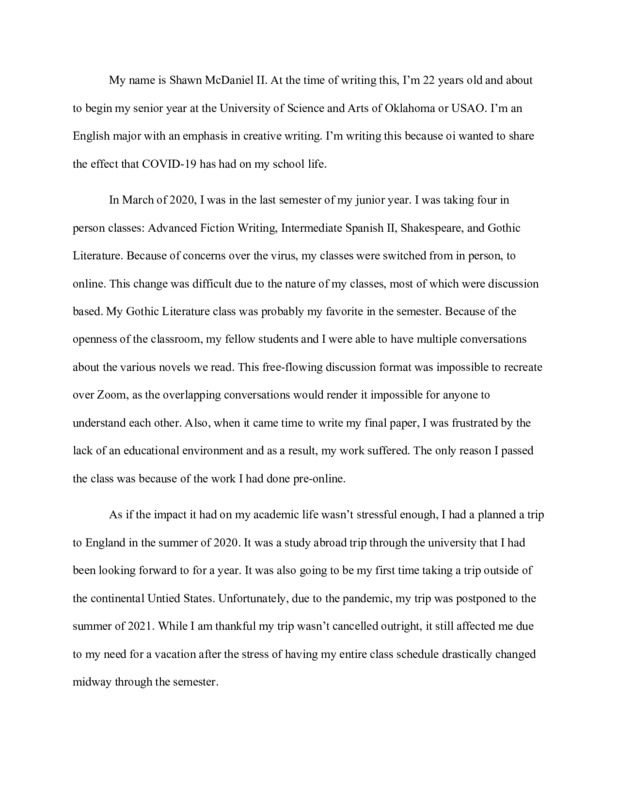 2020-08-07
2020-08-07The Tale of the English Major and the Plague
I have uploaded a written story about how my university adapted to the Covid Pandemic. I wanted to tell the impact it had on my academic career, my personal life, and how my professors adapted to the change. -
 07/25/2020
07/25/2020Cody Brown Oral History, 2020/07/25
This is an oral history interview I conducted with a law enforcement officer and fellow ASU intern. He is in the History Master's program at ASU with me and it gives the perspective of not only a law officer but also one who lives in a very rural area in the United States during the pandemic.
